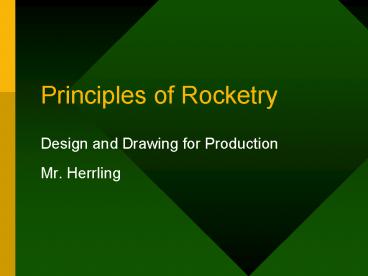Principles of Rocketry - PowerPoint PPT Presentation
1 / 21
Title:
Principles of Rocketry
Description:
Principles of Rocketry Design and Drawing for Production Mr. Herrling Outline: Newton s Third Law Solid Fuel Rockets Liquid Fuel Rockets Water bottle Rockets Forces ... – PowerPoint PPT presentation
Number of Views:368
Avg rating:3.0/5.0
Title: Principles of Rocketry
1
Principles of Rocketry
- Design and Drawing for Production
- Mr. Herrling
2
Outline
- Newtons Third Law
- Solid Fuel Rockets
- Liquid Fuel Rockets
- Water bottle Rockets
- Forces on Rockets
- Rocket Stability
3
Isaac Newtons 3rd law of Motion
- For every action there is an equal and opposite
reaction
4
What is the Action?
- Solid Fuel Rockets
- Fuel in solid form burns and is converted to hot
gasses. - Hot gasses expand and create high pressure.
- Pressure escapes out nozzle, pushing against air
and rocket body equally. - Reaction Rocket moves forward, as gasses move
backwards
5
Gasses RocketAction Reaction
6
More on Solid Fuel Rockets
- Solid-fueled rockets use a fuel and oxidizer in
solid form. The fuel and oxidizer are in a
powdery or rubbery mixture known as the grain or
charge. Once a solid-fueled rocket is ignited, it
burns completely. There is no way to stop the
combustion or to change the amount of thrust.
7
Liquid Fuel Rockets
- Work on same basic principles as solid fuel.
- Carry liquid fuel and oxygen.
- Unlike solid fuel, liquid fuel can be regulated
to control thrust.
8
Liquid Fuel
- Used for launches and interplanetary travel,
liquid fuel rockets are more versatile than solid
rockets because the amount of thrust can be
controlled, but they are less reliable than solid
rocket engines.
9
Space Shuttle
- Liquid Fuel and Oxygen tank feeding Engines
- Solid Fuel Rocket Boosters
10
Propulsion
- All spacecraft need to reach about 17,500 miles
per hour to get into orbit. - Thrust is used to push the spacecraft this fast.
- Thrust is produced by burning a rocket fuel with
oxygen. - If there is not enough thrust the spacecraft will
fall back to earth due to gravity.
11
Our Water Rockets
- Instead of hot gasses creating pressure, we use a
bike pump and store pressure. - Action Expelling water from engine bottle
(water is forced down) - Reaction Water resisting against rocket body
(Rocket is forced up)
12
(No Transcript)
13
Water Rockets Work Like Real Rockets
14
(No Transcript)
15
Thrust
- Forward motion or thrust can best be described by
observing a balloon filled with air. When air is
released from the balloon, forces inside the
balloon cause it to move to the left.
16
Weight
- Weight is the force generated by the
gravitational attraction on the rocket. - We are more familiar with weight than with the
other forces acting on a rocket, because each of
us have our own weight which we can measure every
morning on the bathroom scale. - We know when one thing is heavy and when another
thing is light
17
Drag
- We can think of drag as aerodynamic friction, and
one of the sources of drag is the skin friction
between the molecules of the air and the solid
surface of the moving rocket. - Because the skin friction is an interaction
between a solid and a gas, the magnitude of the
skin friction depends on properties of both solid
and gas.
18
Lift
- The lift force (the aerodynamic force
perpendicular to the flight direction) is used to
overcome the weight. - On a rocket, thrust is used in opposition to
weight. - On many rockets, lift is used to stabilize and
control the direction of flight.
19
Stability During Flight
- The purpose of putting fins on a rocket is to
provide stability during flight, that is, to
allow the rocket to maintain its orientation and
intended flight path. - If a typical amateur rocket was launched without
fins, it would soon begin to tumble after leaving
the launcher, due to the way that aerodynamic and
other forces (such as wind) act upon the rocket,
in relation to the forces that are exerted upon
the rocket by the motor and by gravity.
20
Stability During Flight
- Think about a dart
- Fins or feathers in the rear act like wind veins
and trail behind.
- Heavy mass made of metal carriers the momentum.
21
- The End































